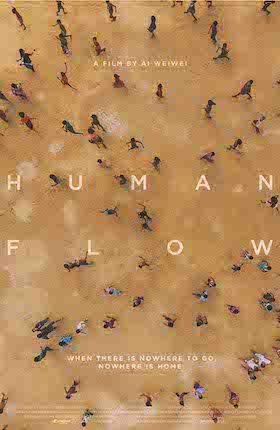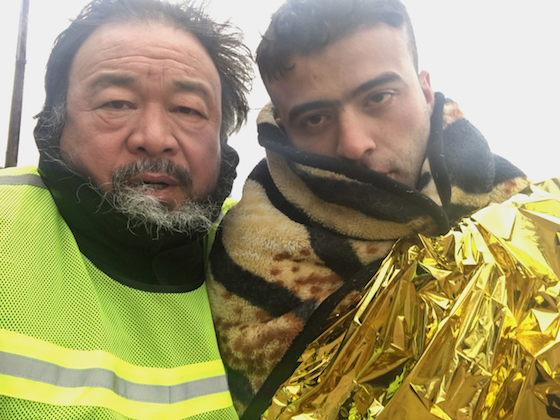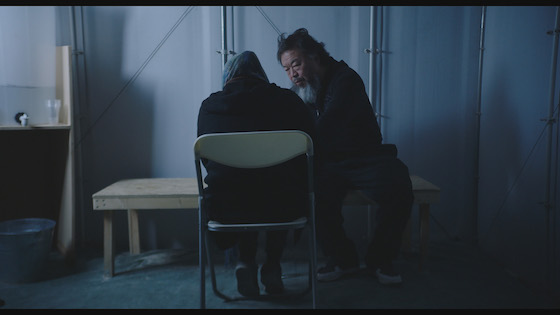Unfocused, indulgent, and scattered, Human Flow, opening at the Tivoli Friday, doesn’t know what it wants to be, and has an even more difficult time trying to figure out what it wants to say. Little better than a first-hand examination of the refugee crisis touching several disparate parts of the world, director Ai Weiwei seems to think it is enough to just point his camera at the problem to get at the heart of it. Yet Human Flow fails to so much as scratch the surface of what’s really at play in all of these different places, and does a disservice to his subjects in the process.
As a documentary, it is all very frustrating. Ai Weiwei and his crew travel to more than a dozen different refugee hot-spots such as Greece, Hungary, Iraq, and even the U.S./Mexico border to get an on-the-ground look at what is going on in each location. Yet rather than focus on the stories of these displaced people, or the larger geopolitical forces at work, the doc opts instead to jump from location to location: the only common thread throughout being the baffling decision to put the director in-frame time and again. Why Ai keeps popping up in his documentary about refugees is a head-scratcher, and keeps happening for no conceivable purpose other than Ai needs to make sure he’s at the center of the narrative.
By the end of Human Flow, after 140+ minutes of meandering from location to location via a dizzying combination of drone, cellphone, and traditional camera footage, it is difficult to say what this film is all about: refugees or Ai Weiwei. And this is maybe the most disappointing aspect of the documentary, as it is about a very real and important issue (forcible displacement) that affects millions of men, women, and children all over the world. The access granted to Ai and his crew afforded them an opportunity to peel back the surface layers covering the ugly underbelly of these different scenarios, yet each geographic portion just skims the surface of what’s going on (i.e., these refugees are fleeing from this place to go to that place), then moves on.
What is at the root of each conflict is never really explored, and except for a few sentences here and there to give only the most basic background, little is said about the governments at either side of the spectrum. What is happening in Syria that has forced untold millions to flee for Europe, and why have countries in Europe begun closing their borders? Sure, there’s war on one end, and a nearly unprecedented influx of refugees at the other, but isn’t there more to it than that? How do the Arab Spring, U.S.-Russia relations, and the rise in nationalist and racist political ideology play into things?
On a more micro level, who are these people, these refugees? Are they teachers, bankers, soldiers, clergy, doctors: outside of their physical condition as displaced persons, who are they and how does that speak to the crisis writ large? At one point, early in the documentary, Ai Weiwei speaks to a Muslim refugee from Myanmar, who talks about his struggle to maintain his humanity in the face of religious prosecution, yet this is about as deep as the film gets in exploring the personal face of this global crisis.
Structurally, there’s problems as well. As already mentioned, the filming format changes repeatedly throughout the picture (there are 12 D.P.’s listed), leaning heavily on drone footage that loses its appeal after the sixth or seventh flyby. Worse still, Ai is incapable of cutting his film effectively, and instead opts to hold his shots far longer than necessary, which creates an empty, motionless pacing structure that makes the whole thing drag. Rather than use his talking heads or testimonials from the countless opportunities presented to him, Ai Weiwei puts text on the screen so the audience can simply read through the important particulars, a move that feels both lazy and amateur-hour-ish.
The result is a rudderless slog that’s more interested in putting Ai on camera than getting at the heart of the issue about which it seems so concerned. There is a global refugee crisis right now, in 2017, and the people at the center of it deserve our attention and concern. And yet, despite Ai Weiwei and his crew’s tireless efforts to visit these different refugee collection points to get a look at what is happening, one walks away from Human Flow even more lost about what is going on than when it began.
And maybe that’s the point: to provoke, frustrate, and just show. Ai Weiwei is primarily known as a multimedia artist, not a narrative filmmaker, and if Human Flow is little more than an artistic meditation on refugees and displacement, that might be something. But it is a documentary film, and as it concerns a deeper understanding of the problem (except that it exists), or even a better understanding of the complications buttressing the bigger issues, then it is a dismal failure.
Unless a person goes into Human Flow with no knowledge of the current state of affairs in Syria, Myanmar, Europe, etc. (so unless a person wakes up from a 10-year coma and walks into this thing), then there’s not a lot of new information on display. Yes, there is a desperate refugee problem spanning the globe, one caused by a tangled web of maneuvering between middle eastern nation states, global superpowers, and a rise in religious and populist extremism. How did the world get to this point, and how does it move forward in a way that addresses the very real human crisis unfolding in front of us every single day? Ai Weiwei doesn’t have any answers, nor does his documentary. And aside from making sure that the director is in a scene every couple of minutes or so, Human Flow doesn’t seem to really care.









Comments on this entry are closed.